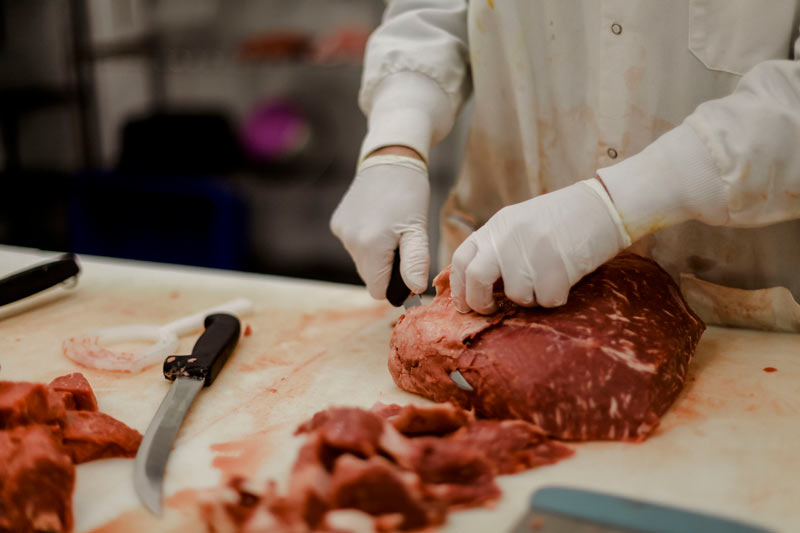Everything About Meat Markets: Comprehending Their Function in Supporting Local Farmers
Meat markets offer a crucial function in regional economic situations by linking the gap in between customers and farmers. They offer a straight sales network that improves the freshness and top quality of meat products. Beyond ease, these markets play a considerable role in promoting lasting farming and supporting the livelihoods of local farmers. The ramifications of this relationship prolong even more than one may expect, increasing concerns about sourcing methods and consumer choices.
The Significance of Meat Markets in Regional Economic Climates
Often neglected, meat markets play a vital duty in bolstering regional economies by supporting farmers and generating work. These facilities offer as essential intermediaries, providing a system for local producers to offer their products straight to consumers. By acquiring in your area sourced meat, customers contribute to the sustainability of close-by farms, ensuring their feasibility and advertising agricultural variety.
Additionally, meat markets develop employment possibility, varying from butchers and sales personnel to monitoring and logistics duties. This job development promotes the local economy, cultivating a feeling of area as locals engage with their community services.
Additionally, meat markets frequently draw in consumers that seek top notch, fresh items, which can bring about enhanced foot traffic and sales for bordering companies. Generally, the visibility of meat markets can greatly enhance regional economic wellness, fortifying connections between agriculture and community wellness while sustaining the resources of farmers.

Attaching Farmers and Consumers: Exactly how Meat Markets Run
Meat markets function as vital centers that connect neighborhood farmers straight with customers, assisting in a streamlined supply chain that profits both events. By sourcing items from nearby ranches, these markets ensure that customers get fresh, top quality meat while sustaining neighborhood farming. The procedure of meat markets entails establishing relationships with farmers, typically permitting them to display their products and share their farming practices.
In turn, consumers access to a diverse selection of meats that show regional tastes and preferences. Openness is a crucial element of these markets, as customers are usually given with information about the sourcing and taking care of of the meat. This straight link cultivates count on and loyalty in between consumers and farmers, boosting community connections. In addition, meat markets regularly participate in advertising activities, such as farm-to-table occasions, which better enhance the consumer's experience and awareness of local farming practices.
Promoting Lasting Agriculture Practices
Advertising lasting farming methods is vital for the future of food production and environmental health and wellness. By concentrating on ethical farming strategies, urging biodiversity, and supporting for regional and seasonal sourcing, the agricultural field can considerably reduce its environmental impact. These techniques not only sustain the community yet additionally cultivate a healthier connection in between farmers and consumers.

Honest Farming Strategies
A growing variety of farmers are taking on moral farming techniques to enhance sustainability and minimize environmental impact. These techniques concentrate on accountable land management, minimizing the usage of chemical plant foods and pesticides, and welcoming natural techniques. Techniques such as plant turning, cover chopping, and agroforestry not only improve dirt wellness however also promote biodiversity. Additionally, farmers are increasingly focusing on pet well-being by giving pasture-based systems and decreasing confinement practices. By focusing on local sources and community involvement, honest farming fosters a resistant farming system. This shift not just benefits the environment but also reinforces the link in between farmers and customers, encouraging educated investing in decisions that support sustainable practices. Inevitably, these strategies offer to produce a much more sustainable future for agriculture.

Biodiversity and Community Health And Wellness
While several agricultural methods have actually traditionally focused on yield over environmental balance, an expanding recognition of biodiversity's significance has emerged among farmers and consumers alike. Biodiversity boosts ecological community durability, sustaining dirt health and wellness, pest control, and pollination. By incorporating diverse plants and livestock, farmers can create much more stable communities that lower dependence on chemical inputs and enhance total productivity. Sustainable agriculture techniques that promote biodiversity not just shield natural environments but additionally add to the long-term practicality of farming. Meat markets play a vital role in this standard shift by advocating for regional items that focus on environmental wellness. By selecting to source from farms that embrace biodiversity, consumers can support methods that guarantee a lasting future for farming and the environment.
Regional and seasonal Sourcing
Seasonal and regional sourcing not just improves the quality of food yet likewise sustains lasting farming practices that profit both customers and farmers. By focusing on neighborhood meat markets, consumers can connect directly with farmers, promoting a sense of community and depend on. This model lowers the carbon impact connected with long-distance transportation, promoting environmental sustainability. Farmers gain from more stable incomes and a trustworthy market for their items, which motivates liable farming techniques. Additionally, seasonal sourcing encourages varied agricultural techniques, permitting farmers to rotate crops and livestock, thus keeping dirt wellness and biodiversity. On the whole, this strategy develops a more durable food system that lines up with the worths of top quality, area, and sustainability support, strengthening the essential web link between customers and regional agricultural systems.
The Function of Openness in Sourcing Meat
What aspects add to consumer count on meat items? Openness in sourcing is an essential component. Consumers progressively look for information concerning where their meat comes from, including the methods and farms entailed in increasing the pets. Meat markets that focus on openness commonly show clear labeling, detailing the resource and production methods made use of. This visibility cultivates confidence and enables customers to make informed choices.
In addition, clear practices can include farm sees, partnerships with neighborhood farmers, and sharing tales regarding the pets and their environments. As customers come to be much more informed regarding food sourcing, they tend to prefer meat items from providers who are honest with information. This demand for openness not only strengthens customer depend on however additionally urges meat markets to establish ethical relationships with neighborhood farmers. Inevitably, transparency sustains a cycle of liability, profiting both customers and manufacturers in the meat sector.
Supporting Pet Welfare Through Local Sourcing
Supporting animal welfare through regional sourcing depend upon the fostering of honest farming practices. By focusing on openness in sourcing, consumers can make informed choices that show their worths. Furthermore, area interaction initiatives cultivate a stronger connection between farmers and consumers, enhancing the general commitment to humane therapy of pets.
Ethical Farming Practices
While consumers progressively focus on ethical considerations in their food choices, neighborhood sourcing uses a practical course to sustaining pet welfare. Ethical farming techniques emphasize humane treatment of pets, ensuring they have adequate room, proper nutrition, and accessibility to exterior environments. Neighborhood farms typically comply with these standards, as they are extra accountable to their consumers and areas. By choosing to source meat in your area, customers can sustain ranches that prioritize lasting and humane methods over industrialized methods, which typically jeopardize pet wellness. This connection promotes a deeper understanding of food production and urges responsible consumption. Inevitably, regional sourcing equips consumers to make educated options that straighten with their values relating to honest treatment of pets in the food sector.
Transparency in Sourcing
How can openness in sourcing improve customer trust fund in neighborhood meat markets? By supplying clear information regarding the beginnings of their items, regional meat markets foster a sense of liability and integrity. When consumers understand the sourcing techniques, consisting of the therapy of pets and farming techniques, they are most likely to feel great in their investing in choices. This openness allows customers to straighten their values with the businesses they support, knowing they are adding to honest animal welfare and sustainable practices. In addition, neighborhood meat markets can display collaborations with close-by ranches, emphasizing community support and strengthening a favorable relationship in between consumers and producers. Eventually, openness in sourcing not only constructs count on yet additionally encourages enlightened selections amongst customers.
Community Engagement Initiatives
What duty do area involvement initiatives play in advertising animal welfare via local sourcing? These campaigns substantially improve understanding and understanding of ethical farming methods amongst customers. By promoting links in between regional farmers and area participants, meat markets can highlight the importance of humane therapy of animals. Educational workshops and farm excursions enable customers to witness firsthand the conditions under which animals are elevated, strengthening the worth of neighborhood sourcing. Furthermore, area events, such as farm-to-table dinners, highlight the partnership between pet well-being and sustainable methods. Via these interactions, consumers develop count on in neighborhood meat markets, urging them to support moral cultivating a culture and sourcing of liable consumption that prioritizes animal well-being in the area.
Health Perks of Finding Citizen Meat Products
Picking regional meat items provides numerous health and wellness benefits that can considerably enhance general health (edwardsville meat market). One significant benefit is the decreased time in between farm and table, which commonly leads to fresher meat with greater nutritional worth. Local meats tend to be cost-free from hazardous chemicals and ingredients frequently found in factory-farmed options, adding to a cleaner diet regimen
Furthermore, local farmers commonly prioritize humane and sustainable techniques, causing much healthier pets that create better-quality meat. Grass-fed and pasture-raised animals, often found in regional markets, generally have greater levels of omega-3 fatty acids and reduced degrees of saturated fats compared to their barnyard equivalents.
Supporting regional meat items promotes neighborhood wellness by guaranteeing that customers have access to secure and sensibly sourced food. By selecting neighborhood, people not just nourish themselves however also add to the wellness of their community and atmosphere.
Making Educated Options at the Meat Market
When going across a meat market, understanding the crucial elements that influence top quality and sourcing can encourage consumers to make enlightened selections. Customers ought to focus on neighborhood products, which usually come from ranches with lasting practices. Recognizing labels such as "grass-fed" or "natural" can also guide choices, as these frequently suggest greater welfare criteria and nutritional benefits.
Involving with the butcher is crucial; knowledgeable staff can supply insights into the sourcing of their meats and suggest cuts that suit different cooking methods. Consumers are motivated to ask about the ranch's practices, including pet treatment and feed.
Additionally, checking out the meat's shade and structure can reveal freshness and top quality. Lean cuts need to appear brilliant and wet, while fatty cuts need to have a marbled look. By integrating these methods, customers can confidently pick meats that line up with their worths and support neighborhood farming.
Frequently Asked Inquiries
What Kinds of Meat Are Many Typically Cost Neighborhood Meat Markets?
Local meat markets typically offer a variety of meats, consisting of beef, lamb, hen, and pork. These facilities often include pop over to these guys specialized cuts, sausages, and locally sourced products, dealing with diverse cooking preferences and client demands.
How Can I Find a Meat Market Near My Place?
To find a meat market close by, one can utilize on-line maps, online search engine, or neighborhood directories - meat markets edwardsville il. Furthermore, asking next-door neighbors or close friends for recommendations frequently produces important insights into the most effective regional options offered
Exist Seasonal Variations in Meat Availability at Meat Markets?
Seasonal variations in meat accessibility at meat markets usually why not try these out occur, affected by elements such as regional farming methods, animal breeding cycles, and seasonal demand. This can impact the kinds and amounts of meat provided throughout the year.
Do Meat Markets Offer Special Promotions or Discounts for Mass Purchases?
Meat markets usually offer special promotions and discounts for bulk acquisitions. This method motivates customers to buy bigger quantities while enabling the markets to handle supply properly, benefiting both customers and the service financially.
Can I Ask For Particular Cuts of Meat at the marketplace?
Yes, customers can frequently request specific cuts of meat at the market. Many butchers are ready to fit special orders, making certain that clients receive the precise cuts they desire, customized to their choices.
By sourcing products from close-by farms, these markets assure that consumers obtain fresh, high-grade meat while supporting regional farming. By focusing on neighborhood meat markets, consumers can link straight with farmers, promoting a sense of neighborhood and depend on. Just how can transparency in sourcing improve customer count on in neighborhood meat markets? Neighborhood meat markets normally supply a variety of meats, including beef, pork, lamb, and poultry. Seasonal variants in meat accessibility at meat markets often happen, affected by factors such as regional farming Clicking Here practices, animal reproduction cycles, and seasonal need.